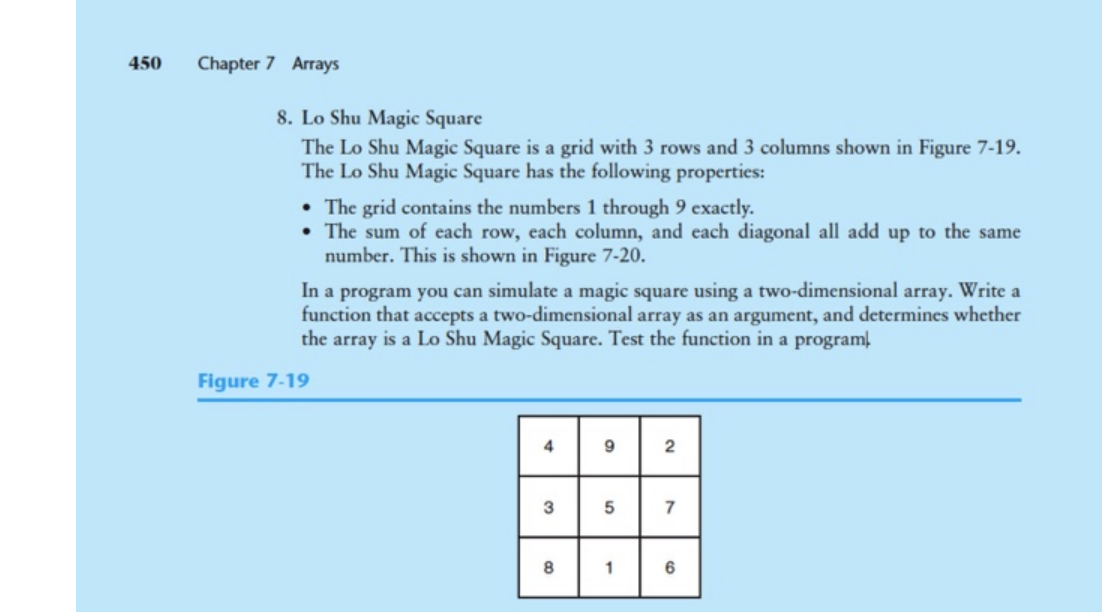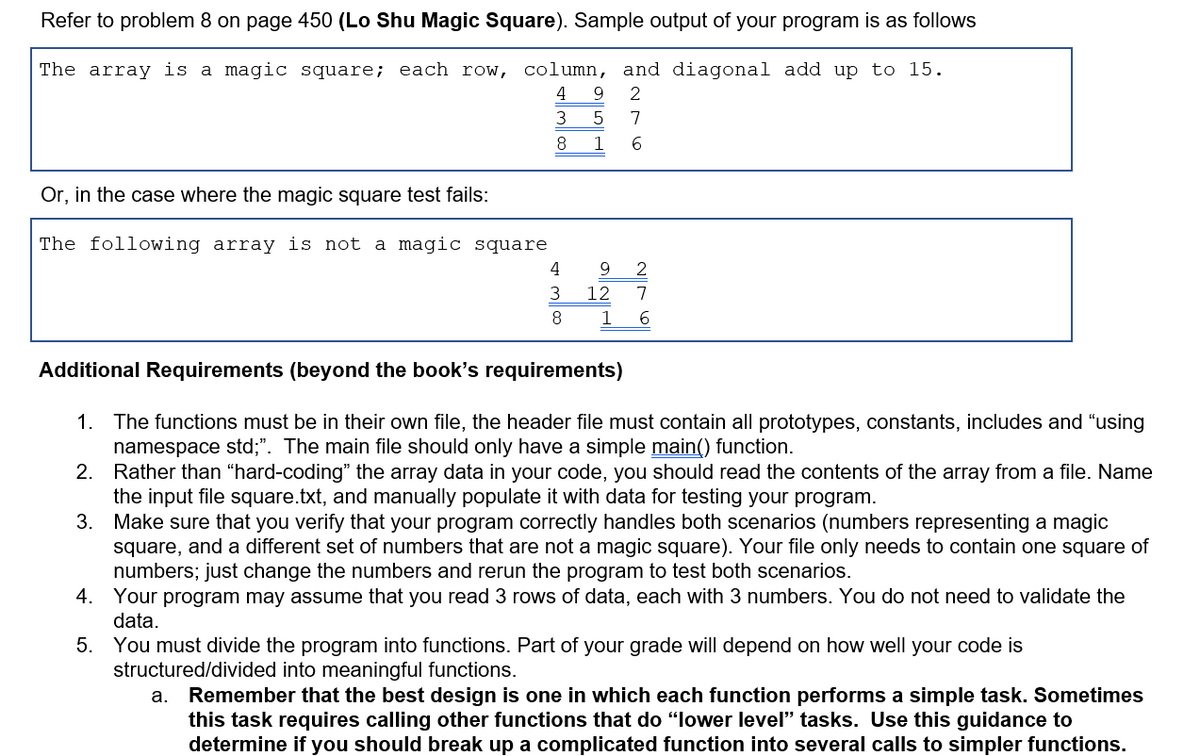450 Chapter 7 Arrays 8. Lo Shu Magic Square The Lo Shu Magic Square is a grid with 3 rows and 3 columns shown in Figure 7-19. The Lo Shu Magic Square has the following properties: • The grid contains the numbers 1 through 9 exactly. • The sum of each row, each column, and each diagonal all add up to the same number. This is shown in Figure 7-20. In a program you can simulate a magic square using a two-dimensional array. Write a function that accepts a two-dimensional array as an argument, and determines whether the array is a Lo Shu Magic Square. Test the function in a program, Figure 7-19
450 Chapter 7 Arrays 8. Lo Shu Magic Square The Lo Shu Magic Square is a grid with 3 rows and 3 columns shown in Figure 7-19. The Lo Shu Magic Square has the following properties: • The grid contains the numbers 1 through 9 exactly. • The sum of each row, each column, and each diagonal all add up to the same number. This is shown in Figure 7-20. In a program you can simulate a magic square using a two-dimensional array. Write a function that accepts a two-dimensional array as an argument, and determines whether the array is a Lo Shu Magic Square. Test the function in a program, Figure 7-19
Computer Networking: A Top-Down Approach (7th Edition)
7th Edition
ISBN:9780133594140
Author:James Kurose, Keith Ross
Publisher:James Kurose, Keith Ross
Chapter1: Computer Networks And The Internet
Section: Chapter Questions
Problem R1RQ: What is the difference between a host and an end system? List several different types of end...
Related questions
Question
please see attached files below
C++

Transcribed Image Text:450
Chapter 7 Arrays
8. Lo Shu Magic Square
The Lo Shu Magic Square is a grid with 3 rows and 3 columns shown in Figure 7-19.
The Lo Shu Magic Square has the following properties:
• The grid contains the numbers 1 through 9 exactly.
• The sum of each row, each column, and each diagonal all add up to the same
number. This is shown in Figure 7-20.
In a program you can simulate a magic square using a two-dimensional array. Write a
function that accepts a two-dimensional array as an argument, and determines whether
the array is a Lo Shu Magic Square. Test the function in a programĮ
Figure 7-19
4
7
1

Transcribed Image Text:Refer to problem 8 on page 450 (Lo Shu Magic Square). Sample output of your program is as follows
The array is a magic square; each row, column, and diagonal add up to 15.
4
3
7
8.
1
Or, in the case where the magic square test fails:
The following array is not a magic square
4
9
2
3
12
7
8
1
6
Additional Requirements (beyond the book's requirements)
1. The functions must be in their own file, the header file must contain all prototypes, constants, includes and "using
namespace std;". The main file should only have a simple main() function.
2. Rather than “hard-coding" the array data in your code, you should read the contents of the array from a file. Name
the input file square.txt, and manually populate it with data for testing your program.
3. Make sure that you verify that your program correctly handles both scenarios (numbers representing a magic
square, and a different set of numbers that are not a magic square). Your file only needs to contain one square of
numbers; just change the numbers and rerun the program to test both scenarios.
4. Your program may assume that you read 3 rows of data, each with 3 numbers. You do not need to validate the
data.
5. You must divide the program into functions. Part of your grade will depend on how well your code is
structured/divided into meaningful functions.
a. Remember that the best design is one in which each function performs a simple task. Sometimes
this task requires calling other functions that do "lower level" tasks. Use this guidance to
determine if you should break up a complicated function into several calls to simpler functions.
Expert Solution
This question has been solved!
Explore an expertly crafted, step-by-step solution for a thorough understanding of key concepts.
This is a popular solution!
Trending now
This is a popular solution!
Step by step
Solved in 2 steps with 2 images

Recommended textbooks for you

Computer Networking: A Top-Down Approach (7th Edi…
Computer Engineering
ISBN:
9780133594140
Author:
James Kurose, Keith Ross
Publisher:
PEARSON

Computer Organization and Design MIPS Edition, Fi…
Computer Engineering
ISBN:
9780124077263
Author:
David A. Patterson, John L. Hennessy
Publisher:
Elsevier Science

Network+ Guide to Networks (MindTap Course List)
Computer Engineering
ISBN:
9781337569330
Author:
Jill West, Tamara Dean, Jean Andrews
Publisher:
Cengage Learning

Computer Networking: A Top-Down Approach (7th Edi…
Computer Engineering
ISBN:
9780133594140
Author:
James Kurose, Keith Ross
Publisher:
PEARSON

Computer Organization and Design MIPS Edition, Fi…
Computer Engineering
ISBN:
9780124077263
Author:
David A. Patterson, John L. Hennessy
Publisher:
Elsevier Science

Network+ Guide to Networks (MindTap Course List)
Computer Engineering
ISBN:
9781337569330
Author:
Jill West, Tamara Dean, Jean Andrews
Publisher:
Cengage Learning

Concepts of Database Management
Computer Engineering
ISBN:
9781337093422
Author:
Joy L. Starks, Philip J. Pratt, Mary Z. Last
Publisher:
Cengage Learning

Prelude to Programming
Computer Engineering
ISBN:
9780133750423
Author:
VENIT, Stewart
Publisher:
Pearson Education

Sc Business Data Communications and Networking, T…
Computer Engineering
ISBN:
9781119368830
Author:
FITZGERALD
Publisher:
WILEY